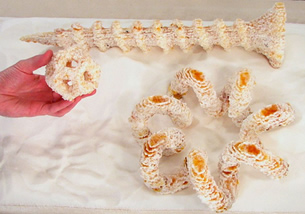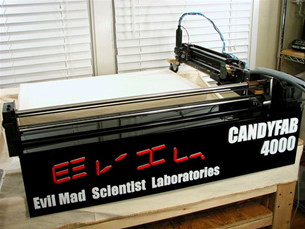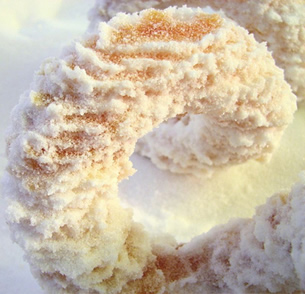3D Printing with a Sweet Tooth
Edible incredibles from CandyFab using solid freeform fabrication.
October 9, 2008
By Susan Smith
 Three objects made out of pure sugar: A little dodecahedron, the toroidal coil, and the 20-inch-long wood screw. |
Halloween is on its way and what better time is there to take a look at the CandyFab Project conceived by physicist and blogger Windell Oskay?
CandyFab showcased its wares at the Bay Area Maker Faire in the San Francisco Bay Area for the first time in 2007 and again in May of this year.
Oskay’s Evil Mad Scientist Laboratories created a do-it-yourself sugar printer project from which they have spun off CandyFab.org to coordinate the development of the open source CandyFab project.
The centerpiece of CandyFab.org is a home-built 3D fabricator capable of creating products using low-cost printing media, one of which is granulated sugar. Instead of running out to purchase a high-end 3D printer, the creators of CandyFab feel a lot can be done with their homemade fabricator that can print several large, low-resolution, objects out of pure sugar. These objects have a large printable volume but less need for precision and high resolution than usual manufacturing processes, according to the website.
While many fabrication processes probably only dream of offering such a “sweet” solution, CandyFab has gone ahead and done it, using a process common to most solid freeform fabrication processes — stacking solid 2D printed layers on top of one another. Using selective hot air sintering and melting (SHASAM), the printing process starts with a bed of granular printing media (sugar) that has a low melting point. By using a narrow, pointed, low-velocity beam of hot air, CandyFab fuses together the print media, forming a layer from the fused granules. By successively lowering the bed slightly, they can add a thin layer of media to the top of the previous one, then fuse the media in the new layer as is done with Selective Laser Sintering (SLS) or Selective Laser Melting (SLM), forming a 2D image that is also fused to the overlapping fused segments in the layer below. As the process is repeated, a three-dimensional object can be slowly built up until you have a finished product.
 3D sugar fabricator |
While SLS and SLM are used to create plastic and direct metal printing, the hot air sintering and melting process replaces those more expensive laser processes that cost $5,000 and up with a $10 heating gun and some recycled components.
Of course, CandyFab’s fab machine offers much lower resolution as well as low cost; its “comparatively large printable volume” is designed for products that require less precision and resolution. As the website suggests, “Our fabricator is not designed for prototyping machine parts; it’s designed for fun, for large-scale 3D illustration, for sculpting, architectural models, and other applications where resolution isn’t the only important factor.”
The total cost estimate on one of these homemade fabrication machines is approximately $500. The heater design essentially consists of a 500 W, $10 air heating element and a small air pump such as a $5 aquarium air pump. Recycled printer and plotter parts from HP, a car jack and other found objects can comprise the design of a CandyFab machine. Print media chosen can range anywhere from some plastics and waxes that have low melting points and are available in powder or granular form, to chocolate chips and some other foods and, most curiously, sugar.
What is the appeal of sugar, besides the obvious? For solid freeform fabrication, sugar is said to be a good printable medium because it is inexpensive, non-hazardous, non-toxic (if not ingested in large quantities), water soluble, kid friendly and rigid despite its low melting point. It can also be used for making some forms for investment casting. The price of sugar can be as low as $.40 a pound, available at your local grocery store.
The fabricator can handle large-volume printing, with a maximum printable volume of 24 x 13.5 x 9 inches (61 x 34 x 23 cm) — 2916 cubic inches, or 1.7 cubic feet, and holds a little more than 100 pounds of sugar, which costs about $37 retail.
 If you look at all closely, you can see the pixelated nature of the fabricated object. The bulk of the material is solid, glassy, lightly caramelized sugar. It feels and acts much like regular glass. The outside surface is covered by loosely attached sintered sugar (white), and can be removed or smoothed over by hand. |
A model of a wood screw made with the fabricator out of sugar is 20 inches long, weighs about 2.5 pounds with head diameter of 4.5 inches, media costs totaling $.93. A similar model made on an industry standard 3D printer could cost much more.
If this news seems offbeat and lacking in seriousness compared to most rapid prototyping processes, look again. The large wooden base upon which the fabricator rests was designed in Google SketchUp. The software that controls the 3D fabricator comes in several different layers and many different techniques are used to implement it. A 3D model generated or imported into POV-Ray, is then rendered as a set of 2D bitmaps of slices through the image. The bitmaps are used to draw with the hot air gun all the black points on the bitmap.
In spite of its humble beginnings, the 3D fabricator requires precision motion control in three directions to operate, and computer control and interface are provided through a MAKE Controller. An older version of LabVIEW is currently used to control the MAKE Controller.
Updates includea new heater design that allows for a significant increase in resolution ofCandyFab. Effective pixel size reduces from about 1/5” to 1/16”. Proceduralchanges have also been made to produce edible output – just in time fortrick-or-treating.
Evil Mad Scientist Laboratories
Susan Smith is a contributing editor for Desktop Engineering magazine. She has been an editor and writer for the technology industry for more than 15 years and resides in Santa Fe, NM. Send e-mail about this article to [email protected].
Subscribe to our FREE magazine, FREE email newsletters or both!
About the Author
DE’s editors contribute news and new product announcements to Digital Engineering.
Press releases may be sent to them via [email protected].






